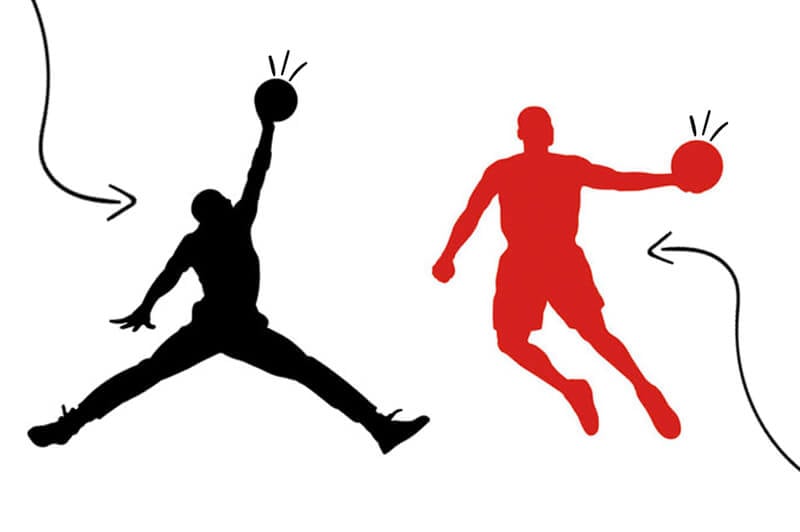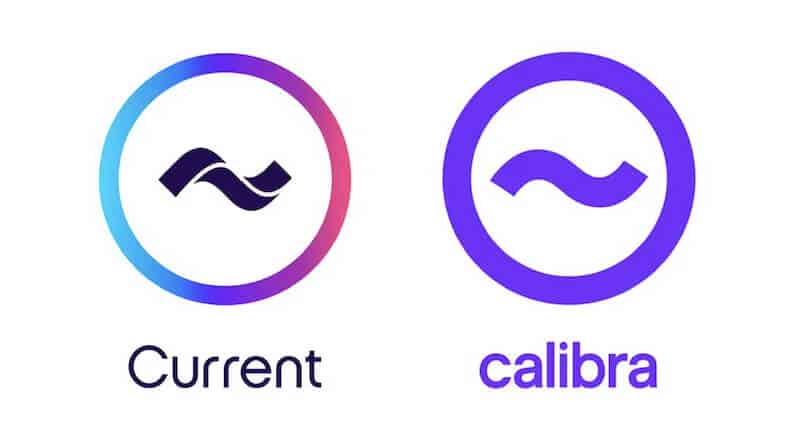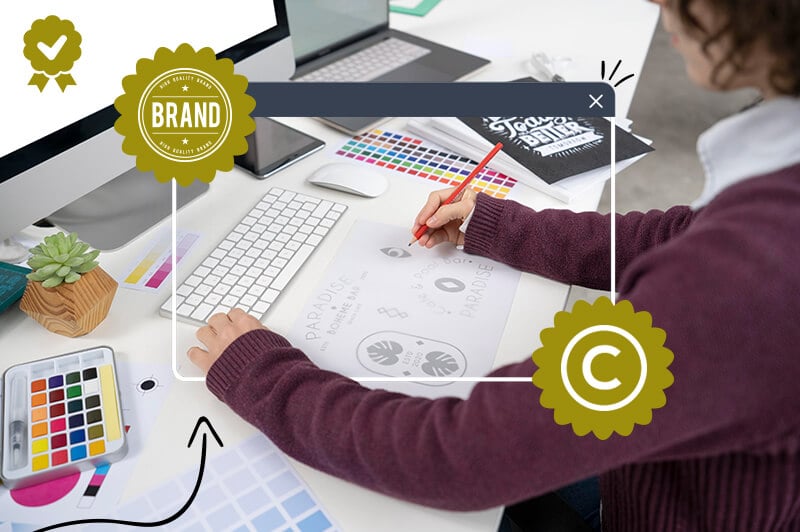Not long ago, Michael Jordan won a lawsuit he filed against the Chinese company Qiaodan Sports. The latter was found guilty of using stark references to Jordan’s brand for advocating for their product line–which is a giant no-no.
Cases like this are why it’s vital to protect your brand and trademark from being infringed upon by other parties through the legal system. These instances are serious enough for a business to go through the process of filing a lawsuit (yes, we said it) against an infringer in order to recover damages from them.

In this post, we’ll cover everything you need to know about logo trademark infringement, including a guide that will help you protect your own trademark from being infringed upon by others.
Before we get into the how’s and why’s, let’s define what exactly we’re talking about when we say “trademark infringement”. Though you can trademark things like phrases and words, we’re going to talk specifically about logo trademark infringement because, well, that’s what you came here for!
When you trademark your logo, you get “priority” to use it. So, when somebody uses your logo without permission, they’re confusing consumers into thinking that your logo is theirs, or that their logo is yours. When another person or company uses elements of your brand that are similar enough to yours that it can confuse consumers, that’s considered logo trademark infringement.
It helps to think about your trademark as one of your business assets. Your trademark represents your brand, distinguishes you from competitors, and gives potential customers a way to both remember your business and come back to you when they’re ready to purchase.
Now, when someone infringes on your logo trademark, they’re essentially using your business for their own means–which you’d have no control over if the law weren’t on your side. Not only can they steal some of your potential business by pretending to be you, but they can also give your business a bad reputation–posting online in your name, talking to your customers however they see fit, etc.
Luckily, logo trademark infringement is a legal offense, and you can take legal action–and may be entitled to compensation–if it happens to you.
The Louis Vuitton vs. Louis Vuiton Dak case is a classic example of why trademark infringement is so serious. A fried chicken restaurant (Louis Vuiton Dak) used an obviously similar name and logo variation to the French fashion house, winding up with a $12,500 fine.
Or, take the Current vs. Facebook showdown, where online startup bank Current saw that the social media giant’s cryptocurrency service, Calibra, was using a startlingly similar logo to theirs. They filed a lawsuit against Facebook for trademark infringement, and Facebook went ahead and changed both the digital wallet’s name and logo design. It doesn’t matter that Facebook is a giant and Current is, well, probably a company you haven’t heard of; the law is the law when it comes to trademark infringement.


Now that you know why logo trademark infringement is so important, let’s take a look at 5 things you can do to (hopefully) prevent it from happening in the first place.
The first way to defend your logo from trademark infringement is to actually create a mark that is difficult to copy by chance–in this case, a “fanciful” or “arbitrary” mark.
A fanciful mark is a name that’s made up, like Nike or Kodak–making the chances of someone else trying to take it relatively low. Arbitrary marks, on the other hand, are common words that are paired with a specific product that doesn’t match the name, like Apple or Domino’s.
There are a few reasons why using fanciful or arbitrary trademarks can help prevent infringement. Firstly, choosing one of these marks will provide you the highest level of protection, because they tend to be creative. The likelihood that one of your competitors will think of either one on their own is very slim, and therefore minimizes the chances that your logo bears any resemblance to your competitors’ logos.
The downside of using either a fanciful or arbitrary mark is that they both can be difficult to market. A fanciful mark will take time for your audience to understand (after all, it takes most of us a few tries to remember a new word we learned), while an arbitrary mark will require some education to your audience of the “unrelated” products/services it represents.
So, make sure you have a plan in place for getting your brand name out there before creating your mark.
If only you could choose any logo you like and immediately trademark it! Unfortunately, you must check your competitors’ logos first and make sure that they’re not already using your mark, or a mark similar to yours. Though it can be frustrating to find out that your logo is already taken, the last thing you want to do is infringe on someone else’s trademark, for the reasons we covered above.
Take note of your competitors’ logo designs, including the color schemes and fonts, and see if anything looks remotely close to your own mark.
Many trademark disputes actually come from marks that could cause confusion with another existing mark as opposed to exact logo matches, which is why it’s recommended to hire a trademark attorney or intellectual property attorney to do a comprehensive search and analyze any similarities in question.
Just doing a reverse-image Google search of your mark will not alert you to any potentially confusing designs, and it’s best to leave it to the lawyers.
And after they’re done? You can go ahead and step into the next phase of trademarking your logo, which is….
Once you’ve searched competitors’ logos and are as sure as possible you’re avoiding trademark infringement, it’s time to register your trademark with the United States Patent and Trademark Office (USPTO).
If you’ve heard that you’re already protected once you start using your mark, that’s partially true; you do get some amount of local protection, in that you may have legal rights to the mark just in your area.
But if you want to use your mark in connection to your business in other parts of the country–or you want to stop someone else in the country from using your trademark for their own business–you don’t have much recourse without registering with the USPTO.
Registration typically takes between 12-18 months (though it’s impossible to know exactly how much time it will take in advance, as there are several stages to the application process). There’s also the possibility that your trademark may not ever register, due to various legal reasons. You can check out the entire trademark registration process on the USPTO’s official website.
Note that, though your trademark won’t expire as long as you continue using the products/services that were in your initial application, you do have to renew your trademark registration to stay protected.
The USPTO won’t remind you about your renewal dates, so make sure to pencil it into your calendar; the first renewal is between your trademark’s 5th and 6th years of use; the second is between your 9th and 10th year after your initial registration date; and the following renewals are every 10 years after that. If you miss a renewal, your trademark will be canceled.
Another way to keep people from infringing on your trademark? Letting them know it exists! The more ways you’re able to show that you’re a credible business owner, the more likely it is that people will shy away from using your mark without permission.
Ideally, you’d use common trademark signs wherever your business shows up–whether that’s your website, packaging, or any other marketing materials. Notice how there’s a little ® symbol next to the Starbucks name right there in the Starbucks website header? You can use that symbol once you’ve registered your mark with the USPTO, to let people know that your mark is federally protected. Or, use the ™ (trademark) or SM (service mark) signs if you haven’t yet registered.
Though your mark is protected by the USPTO, they’re not going to actively check if anyone is infringing on it; that’s your job. You should periodically search for both legal threats and infringements so you can fight them as soon as possible.
Start by regularly checking USPTO trademark filings, opposing any that seem similar to yours if they come up.
In addition, you can use Google Alerts (or other search engines) to automatically email you when any website or news story mentions your name, to make sure that they aren’t misusing it or claiming your mark as their own. Include misspelled versions of your mark and phrases that are similar to it in the alert. You can do the same on social media with social listening tools like Mention.
And, if you have some money to spare on trademark management ($500 per year, for example), you can use trademark search firms like CompuMark to monitor both national and international trademark registrations, domain registrations, etc. in addition to letting you know if there are any companies who are using marks that are similar to yours.
What happens if you do find someone infringing on your mark? Usually, all it takes is a cease-and-desist letter to let the infringer know.
If that doesn’t work, you have the right to file a trademark infringement lawsuit to vindicate your rights when necessary. This will help you both prevent people from using a mark similar to yours in the future, and seek damages if the trademark infringement harmed your business in some way.
Though it may sound like a headache, protecting your trademark is an important part of keeping your business and reputation under your control.
Now you know that trademarks not only protect your brand but also provide the necessary foundation to build up your company’s reputation. Your logo is a main element of your brand, AKA what your company is known and remembered by. If the design is stolen or infringed upon, it will result in a loss of credibility and trust that can have serious consequences on your business. Make sure to prioritize trademark protection, and remember to renew your trademark on time!
This portion of our website is for informational or educational purposes only. Tailor Brands is not a law firm, and the information on this website does not constitute legal advice. All statements, opinions, recommendations, and conclusions are solely the expression of the author and provided on an as-is basis. Accordingly, Tailor Brands is not responsible for the information and/or its accuracy or completeness. It also does not indicate any affiliation between Tailor Brands and any other brands, services or logos on this page.
Products
Resources
©2025 Copyright Tailor Brands